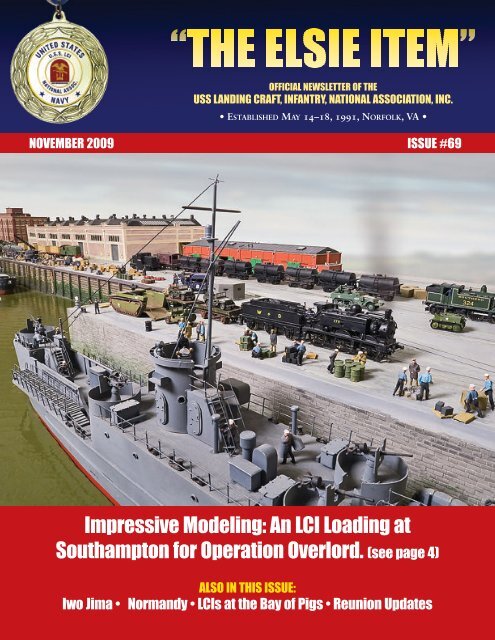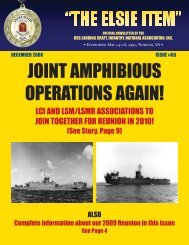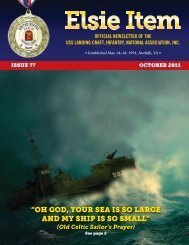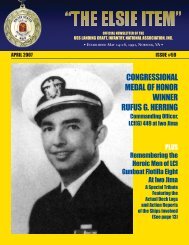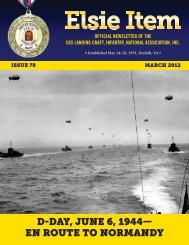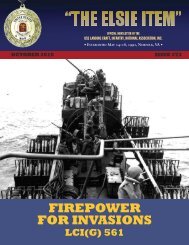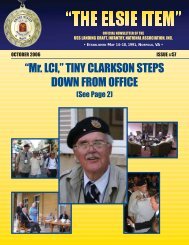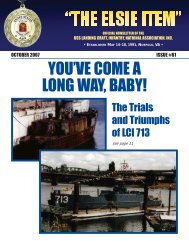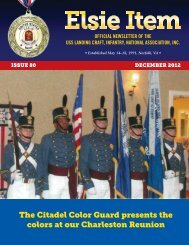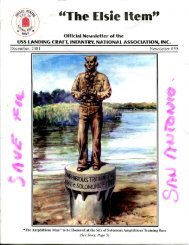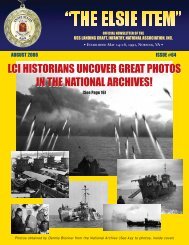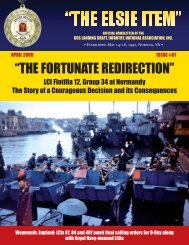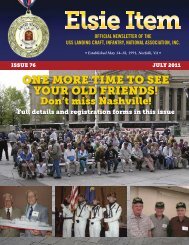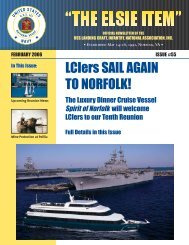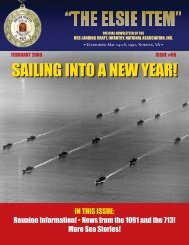elsie item issue 69 - USS Landing Craft Infantry
elsie item issue 69 - USS Landing Craft Infantry
elsie item issue 69 - USS Landing Craft Infantry
You also want an ePaper? Increase the reach of your titles
YUMPU automatically turns print PDFs into web optimized ePapers that Google loves.
OFFICIAL NEWSLETTER OF THE<br />
<strong>USS</strong> LANDING CRAFT, INFANTRY, NATIONAL ASSOCIATION, INC.<br />
• ESTABLISHED MAY 14–18, 1991, NORFOLK,VA •<br />
NOVEMBER 2009 ISSUE #<strong>69</strong><br />
Impressive Modeling: An LCI Loading at<br />
Southampton for Operation Overlord. (see page 4)<br />
ALSO IN THIS ISSUE:<br />
Iwo Jima • Normandy • LCIs at the Bay of Pigs • Reunion Updates
2<br />
“THE ELSIE ITEM” Number <strong>69</strong> • November 2009<br />
Official Newsletter of the <strong>USS</strong> LCI National Association, a non-profit veteran’s organization. Membership in the <strong>USS</strong> LCI<br />
National Association is open to any U. S. Navy or U.S. Coast Guard veteran who served aboard a <strong>Landing</strong> <strong>Craft</strong> <strong>Infantry</strong>. Affiliate<br />
membership, without voting privileges, is offered to others.<br />
Published quarterly by the <strong>USS</strong> LCI National Association. John P. Cummer, Editor. Any material for possible publication should<br />
be sent to the Editor, preferably by email (cummerj@bellsouth.net) or by regular mail to 302 Pinewood Cottage Lane,<br />
Blythewood, SC, 29016<br />
CHECK OUT THESE WEBSITES:<br />
www.usslci.com www.amphibiousforces.com<br />
Our own website For information on the 713 and Tiny’s Ships Stores<br />
On Our Cover: English Railroad Modelers have created an outstanding display of the docks at<br />
Southampton as preparations were being made for D-Day. Chris Mead, one of the modelers has<br />
contributed a finely detailed model of an LCI, featured in the exhibit. See story, page 4.<br />
HAVE YOU PAID YOUR DUES ?<br />
We need the support of every shipmate to keep our Association going!<br />
If you have not yet paid your dues for this year, please do so at once. It will be necessary<br />
to drop you from the Elsie Item mailing list if we do not receive your dues before the next<br />
<strong>issue</strong> comes out. We don’t want to do that!<br />
Your support in keeping our Association going will be greatly appreciated by all your<br />
shipmates and their families...and we’re sure you’ll want to keep on receiving Elsie Item.<br />
Annual dues are $25.00. Please note: Beginning this year we are asking Life Members<br />
also to pay annual dues.<br />
Please make your check out to<br />
“<strong>USS</strong> LCI National Association”<br />
and mail it to:<br />
<strong>USS</strong> LCI National Association<br />
c/o Nehemiah Communications, Inc.<br />
101 Rice Bent Way, #6<br />
Columbia, SC 29229
From the Editor/President<br />
Welcome to another <strong>issue</strong> of Elsie Item !<br />
Recently one of our shipmates wrote me mildly complaining that there<br />
was too much coverage of the restoration work being done on the<br />
1091 and the 713 and not enough about our actual WWII experiences.<br />
This <strong>issue</strong> should help correct that balance. In it I believe we<br />
have more sea stories, first hand accounts and information on operations<br />
in both the Pacific and the European theaters than we have ever<br />
carried before. One reason for that is the outpouring of sea stories<br />
from so many of you. We hope you keep them coming.<br />
I have a couple of requests or suggestions to pass along to you who are still thinking about the<br />
sea story you want to contribute. First, it is so much more easier on me if you send them as an<br />
attachment to an email. That saves a lot of re-copying. Of course, if you do not have access to a<br />
computer, we will be equally glad to receive your story. Another suggestion is that you might<br />
want to try to single out some specific incident – dramatic or funny – and tell us that story instead<br />
of recounting the experiences that were common to most of us – our training, ocean voyages, etc.<br />
Try to think of some experience that you had that may be completely different from those of other<br />
LCIers. However, please send whatever you want in whatever form you prefer, for we will be very<br />
pleased to receive every contribution.<br />
In this <strong>issue</strong> there should be something to satisfy almost everyone -. From our cover story of the<br />
amazingly detailed model of the docks of Southampton, England, as preparations were being made<br />
for the Normandy Invasion to the report of the finding of a paddle that belonged to LCI 93. From<br />
the Pacific theater we carry the sobering story of Nick Grosso and LCI 450 as they participated in<br />
the invasion of Iwo Jima.<br />
We also extend our thanks again to LCI Historian Dennis Blocker for supplying us with more great LCI<br />
photos uncovered in the National Archives. You’ll find them scattered them throughout this <strong>issue</strong>.<br />
Putting on my President’s hat, it’s good to report that plans for our joint reunion with the LSM/LSMR<br />
group are firming up. We think both groups will enjoy the fellowship. In that regard we note with<br />
pleasure the report of the California LCIers meeting together with LST veterans. Seems they all had<br />
a great time together and we hope the same thing will happen next August in Cincinnati.<br />
We continue to be encouraged about the increasing role affiliates are playing in our association. The<br />
enthusiasm they show bodes well for our future. We will be seeking legal advice concerning changes<br />
that need to be made in our by-laws to permit their full participation. Of chief concern will be the<br />
need for preserving our status as an organization to which tax-free contributions can be made.<br />
Fair winds and following seas, Shipmates!<br />
—John Cummer<br />
3
4<br />
Preparation for “Operation Overlord”<br />
Created by English Modelers<br />
Detail of the figures on the LCI
One never knows when “bread cast upon the<br />
waters” comes back! Seven years ago we responded<br />
to a request from Chris Mead, a modeler in<br />
England, for LCI plans. We’ve asked Chris to tell us<br />
a bit about this display and his work on the LCI in it.<br />
LCIs are not forgotten in England!<br />
Railroad modelers have constructed “Overlord,” a display<br />
that has been years in the making.<br />
One might think that a model railroad display is a<br />
strange place to find a model of an LCI, but this is<br />
indeed the case. “Overlord” is a UK based layout<br />
designed to be exhibited at railroad shows that<br />
depicts the preparations for D-day in and around the<br />
Southampton docks during June 1944. It began in<br />
1994 measuring just 12 feet from end to end, and has<br />
proved so popular that after nearly fifteen years and 90<br />
shows including trips to Belgium, the Netherlands and<br />
even Germany, it is still going strong and now measures<br />
over three times its original length.<br />
One of the reasons to extend the layout was to display<br />
a wider selection of the ships of the invasion<br />
armada. Uppermost on the list were both the LCI &<br />
LST. After contacting the <strong>USS</strong> LCI Veteran’s<br />
Association in 2002, I received a letter from Jim<br />
Talbert and John Cummer giving links to all the<br />
images on the website and also copies of LCI plans.<br />
Seven years later, the LCI is complete enough to be<br />
included in “Overlord” and now sits on the layout as<br />
an integral part of the display. Prompted by the need<br />
to write an article on the layout for a magazine and<br />
seeing the results of the accompanying professional<br />
photographs (which are reproduced here by kind permission<br />
of Chris Nevard and the Hornby Magazine) I<br />
thought it only right and proper to contact Jim and<br />
John again to show them the result of their kind<br />
offer of information all that time ago.<br />
Construction of the model began with enlarging the<br />
plans from 1:96 to the scale used on the layout of<br />
1:76 (this is the common scale for both military and<br />
railroad models in the U.K.) which makes the finished<br />
model about 2 feet in length. The material<br />
used throughout is plastic sheet of varying thicknesses—40<br />
thou for the hull and decks with 10 and<br />
20 thou for the superstructure and conning tower.<br />
The thinner gauge allowed the sheet to be rolled<br />
around a a metal rod to produce the curves of the<br />
cabin deck and conning tower.<br />
Copious amounts of filler allowed the lines of the<br />
bow to be shaped and also covered the many joints<br />
and gaps between<br />
the sheets! The rest<br />
of the deck fittings<br />
and armaments are<br />
made from a combination<br />
of more plastic<br />
sheet for the<br />
vents, lockers and<br />
doors, metal rod and<br />
tubing for the armaments,<br />
wire for the<br />
railings and a few<br />
purchased fittings<br />
such as the mooring<br />
bollards and jolly<br />
boat.<br />
Although the LCI is<br />
good enough for display<br />
to the general<br />
Model builder<br />
Chris Mead<br />
public, there is still plenty of detail to add, not least<br />
the choice of an appropriate number. Fortunately my<br />
recent correspondence with John Cummer has provided<br />
the answer. He wrote:<br />
‘This is of particular interest to me because my LCI,<br />
the 502, was one of several craft put under British<br />
control as a part of Assault Force George—and we<br />
loaded from those very docks in Southampton. We<br />
carried troops of the Durham Light <strong>Infantry</strong> and landed<br />
them on Gold Beach at about 1030 hours on 6 June’.<br />
“Overlord” has a number of exhibitions planned over<br />
the last months this year and throughout 2010. With<br />
any luck by the time the first of these comes around<br />
the currently anonymous LCI will be sporting a white<br />
conning tower with blue band and the number ‘502’<br />
on the bows.<br />
I hope I have done these small but important ships<br />
and all those who served in them justice. If you have<br />
any comments, please feel free to contact me at<br />
christopher.mead1@ntlworld.com or through our<br />
society’s website www.lwmrs.co.uk<br />
This layout goes to shows throughout the year. The<br />
next ones are: October 24–25—Warrington;<br />
November 21–22—Southend-on-Sea; December<br />
12–14—Wigan’ and January 16–17—Warwick (this<br />
is my Society’s own show)<br />
I hope some of your members can come along to<br />
one of them, I would really enjoy meeting them.<br />
5
6<br />
Paddle from LCI 93 Found!<br />
After 60 years, a paddle from LCI 93 has been found!<br />
The wreckage of LCI 93, one of the Coast Guard manned LCIs that was lost at Normandy, has disappeared<br />
long ago but now a paddle belonging to that ship; has been found.<br />
Kevin Clarke, an Englishman who owns a house off of Utah Beach in Normandy, recently contacted<br />
LCI Historian John France with the news that the paddle had been found in his attic.. This house<br />
was in the middle of the drop zones for the 101st and 82nd Airborne Divisions on D Day. The<br />
house was occupied by two German officers at the time.<br />
Along with the pictures shown here, Kevin wrote, “ I have found lots of war memorabilia in and<br />
around the house as it was occupied by two German officers during the war and is right in the centre<br />
of the drop zones for the Airborne Div. I have dug up several spent carbine rounds in the garden - I’m<br />
sure some kind of firefight may have taken place there. It certainly makes gardening interesting!<br />
“My wife picked up 2 life belts off Utah Beach a couple of years ago, still in reasonable condition,<br />
amazing to think that they had been in and out of the water for over 60 years.
California LCIers to Host Pearl Harbor Day Luncheon<br />
California State Director Joe Flynn announces that the annual Pearl Harbor Day luncheon will be<br />
held at 11:30 AM, Saturday December 5, 2009 at Hunter Steak House, 1221 Vista Way,<br />
Oceanside, CA.<br />
“There is easy access to the luncheon location from the freeway,” reports Joe. “There will be no<br />
registration fee, but you’ll have to bring at least one LCI story to get in. (Don’t worry – if you<br />
don’t have one there will be plenty of old timers there with who will be happy to share one of<br />
theirs with you!)<br />
For full information and directions, contact Joe at 627 Bradford Road, El Cajon, CA 92019. Joe<br />
can be reached by phone at 588-7078 or by email at joeglo@msn.com.<br />
Space is limited, so please register by November 27, 2009<br />
The Ohio LCI Association: Report on the Sixth Reunion<br />
On Wednesday, September 9th, 2009, The Ohio LCI Association held their 6th Reunion and dinner<br />
banquet at the Radisson Hotel in Columbus, Ohio. This year was extraordinary due to the fact<br />
that we had in attendance the Navy Public Affairs Officer from Columbus, Keith Bryska, our Guest<br />
Speaker, Command Master Chief, Donald Magnes and (9) Chief Selectees. The Chief Selectees<br />
(due to be promoted to Chief on 9/14/09) asked if they may have the opportunity to attend our<br />
dinner banquet so they could have the pleasure of meeting Navy Veterans that served on LCIs during<br />
WWII.<br />
We started with a Memorial Service to pay tribute to (4) fellow Ohio LCIers that had passed<br />
recently. Six of the Chief Selectees felt honored to participate in the Memorial Service and did<br />
the readings for the Rose Ceremony (written by the National LCI Auxiliary Chaplain Michael<br />
Gatton).<br />
Prior to our Guest Speaker, our own Treasurer, Diane Churchill, gave a talk on Women on the Home<br />
Front and Military during the 1940s. She ended with a few words from “Bell Bottom Trousers” as<br />
a special tribute to her very own Sailor, Dick Churchill. Our Guest Speaker, Command Master<br />
Chief Donald Magnes ((30) years in the Navy) followed with a talk about his Navy Career, the Navy<br />
Today and a heartfelt tribute to all WWII Navy Veterans.<br />
It was decided to hold our Seventh Reunion in combination with the National Reunion, which will<br />
be held in Cincinnati, Ohio in 2010.<br />
Submitted by James Aydelotte<br />
Director, Ohio LCI Association<br />
7
MORE INFORMATION ON LCIs AT NORMANDY<br />
In researching the sinking of LCIs 219, sunk<br />
June 11, 1944, off Utah beach by German aircraft,<br />
and LCI 232, sunk by mines off of Utah<br />
Beach, June 6, 1944. I came across an eyewitness<br />
account of the sinking of both LCIs<br />
which I will be posting in future editions of<br />
Elsie Item after I have had a chance to examine<br />
these accounts closely.<br />
However I do have other information. In running<br />
searches on the web for LCI 219, I came<br />
upon a site called “Hyper War” which I found<br />
to be a great source of information. Among<br />
other things I found two interviews done by<br />
the Navy. One was with an officer of LCI 232,<br />
made just two months after it was sunk. The<br />
other was with a member of the salvage crew<br />
that searched and found the wreckage of LCI<br />
232 (but was unable to salvage) off of Utah<br />
Beach.<br />
Subsequently, in scanning the Hyper War web<br />
site I found information concerning Coast<br />
Guardsmen who were decorated for their part<br />
in the invasions at Sicily, Salerno and Anzio. I<br />
was excited to find the record of an LCIer<br />
killed in action who is not listed in the<br />
“Memorial” section on our LCI web site. The<br />
Hyper War site even has this war time address<br />
of this LCIer - a lead for a follow up biography<br />
of this brave man:<br />
John C. Scheuerman<br />
Seaman 1c, USCGR<br />
107 Belenheim Road<br />
Columbus, Ohio<br />
8<br />
By<br />
John France<br />
LCI Historian,<br />
European Theater of Operations<br />
I learned that John was awarded a Silver Star<br />
(Posthumously). The citation for this award<br />
reads as follows:<br />
While serving aboard the <strong>USS</strong> LCI(L) 319 during<br />
the amphibious invasion of Italy, September<br />
9, 1943, observing an enemy fighter plane diving<br />
in for a strafing attack as vessel<br />
approached the assault beaches in the Gulf of<br />
Salerno, he unhesitatingly manned his battle<br />
stations and exposed anti-aircraft gun, and<br />
with cool courage exerted every effort to<br />
direct accurate fire against the plane.<br />
Although mortally wounded before he could<br />
deliver effective fire, he remained steadfast at<br />
his post in the face of imminent death, thereby<br />
contributing materially to the protection of the<br />
ship against further attack.<br />
I looked up LCI 319 on NavSource and found<br />
that it lists five Purple Hearts awarded and<br />
one KIA reported for September 11.<br />
Scheuerman was not listed but perhaps he<br />
died two days after being hit. I will follow up<br />
on this at a later date and write the story.<br />
However, in the meantime, his name will be<br />
added to the “Memorial” list on our website.
These posters inside a German bunker on the Normandy Coast<br />
show that they knew what an LCI was!<br />
9
OK, Shipmates! It’s that time again! Here are<br />
a few more...pull up an easy chair, relax and<br />
get ready for some more LCI yarns. The first<br />
two come from George Weber, who served on<br />
LCI(FF) 370.<br />
About Those Eye Exams<br />
Arthur Chermon LCI(L) 364 wrote about ‘fudging’<br />
on passing the recruitment eye exam.<br />
Here’s my version of that endeavor made on<br />
my part.<br />
I was a senior in high school during the<br />
1942-43 school year. I had heard from many<br />
sources that [1] If your grades were good, [2]<br />
If you had accumulated a reasonable number<br />
of credits [3] If you had less than one semester<br />
left before graduation, and [4] If you were<br />
younger than 18 [whereupon you were required<br />
to register for the draft] - THEN if you volunteered<br />
for the military you would receive your<br />
diploma and be allowed to select which service<br />
you wished to join and which service<br />
school you wished to attend.<br />
Well, I could fill the bill on all those requirements,<br />
by the skin of my teeth. I would be 18<br />
on Jan. 12, 1943. School would be resuming<br />
after Christmas break 5 days before that birthday.<br />
So if I attended four of those five days, I<br />
would have less than a semester left before<br />
graduation. So I planned on driving over to<br />
Terre Haute, Indiana on the 11th of January<br />
[my last day at age 17] and volunteer. But to<br />
make certain that the info I had was true, on<br />
the 10th, at school, I went down and spoke to<br />
the high school principal. Yes, that’s true, he<br />
assured me. Then - to my surprise - he called<br />
a ‘whole school assembly,’ and gave a long<br />
speech praising me for my patriotism. Being a<br />
bookish introvert, I was very embarrassed by<br />
this.<br />
10<br />
More Sea Stories!<br />
Our school, out in the boondocks, had no<br />
health office or school nurse, so I had never<br />
had an eye exam. It being the Great<br />
Depression, I had never seen a doctor - what<br />
you did only if it seemed certain you were<br />
about to die! So I was quite shocked the next<br />
day when I flunked the eye exam, and was<br />
rejected from enlistment.<br />
Fortunately I was left alone for awhile in the<br />
room with the eye chart, and I proceeded to<br />
memorize the middle three lines on it. Then I<br />
drove as fast as I could the 100 miles to<br />
Indianapolis - the nearest other recruiting station<br />
- getting there just 10 minutes before the<br />
stopped beginning physicals at 3 PM. And<br />
they had the same eye chart, so I ‘passed.’<br />
Upon arrival at Great Lakes boot camp, we had<br />
another physical with the same eye chart, so I<br />
passed again.<br />
And here’s George’s second sea story:<br />
Some Inconveniences of an<br />
Increase in One’s Sense of Smell<br />
After having departed from Pearl Harbor<br />
enroute to the invasion of Iwo Jima, we were<br />
never near any land mass other than small<br />
atolls and isolated islands of the Pacific until<br />
the war was over. Being away from any traffic<br />
fumes or industrial odors, we gradually<br />
regained our sense of smell. At first we<br />
became aware of smells that we could smell<br />
all along, like cooking cabbage, which now<br />
became so strong you almost wanted to jump<br />
overboard to avoid it!<br />
Then we became acutely aware of our own<br />
body smells. With no water condensers on our<br />
pipsqueak of a vessel we had to conserve<br />
what water we had in our potable water tanks.<br />
Water was used ONLY for cooking, drinking,
first-aid wound washing and brushing our<br />
teeth. Latrine flushing, deck scrubbing, washing<br />
our hands and faces, and showering were<br />
done with ocean water.<br />
The “saltwater soap” which was provided<br />
was not very efficient. In large, brown,<br />
unscented cakes, you could scrub and scrub<br />
with it and would never get a lather – jut a<br />
slimy film on your skin to smear around. No<br />
matter how hard or how long you scrubbed,<br />
you could smell your body odor right there in<br />
the shower! We found that the inexpensive<br />
black plastic combs the ship’s stores had<br />
smelled very strongly of vinegar and rotten<br />
meat! We would pinch our noses shut when we<br />
combed our hair. It would seem that the fumes<br />
from our ship’s engines would have prevented<br />
this “olfactory recovery” but they didn’t.<br />
From Iwo Jima we went to Leyte Gulf, then<br />
to the invasion of Okinawa. After Okinawa<br />
was “secured” I got ashore for a stroll around.<br />
Having grown up on a small farm in Indiana, I<br />
was enjoying the smells of the earth, crushed<br />
plants, etc. (Also I was having trouble keeping<br />
vertical on the uneven ground, having walked<br />
on nothing but smooth metal decks for months<br />
on end!) THEN I smelled a smell that made<br />
me suddenly very homesick for that Indiana<br />
farm. It was a smell that seemed on the borderline<br />
between pleasant and unpleasant. but<br />
mainly pleasant to me because of its nostalgic<br />
content.<br />
I started following my nose into a small village<br />
of stone fences and stone houses. The<br />
smell kept getting stronger and, finally, I had<br />
zeroed in on it. It was just over this stone<br />
fence. I found a stone to get up on, looked<br />
over that fence and voila! – there was the<br />
source of this “Indiana Farm” smell – a chicken<br />
coop!<br />
I guess you could say “Nostalgia is where<br />
you find it!<br />
Making a Ship Sailing<br />
the Hard Way<br />
From Connie Mulherin, LCI(G) 561<br />
We’ve carried stories from Connie in the past,<br />
but he’s always good for at least one more.<br />
From his memoirs, here is one about an adventure<br />
he and some of his shipmates during<br />
March, 1945, while in the Gulf of Leyte<br />
Thanks to our “benevolent” skipper (LTJG Keith<br />
Mann), we had a rather involved adventure on<br />
our last day in Leyte Bay. We had deliberately<br />
run the ship nose first onto the beach in order<br />
to take on water. A few of us – Dick Cole,<br />
Milt Sanford, Ed Donahue, Joe McDermott,<br />
Walt Whitlow and myself- (a motley crew, I<br />
might add) wandered away from the ship while<br />
the task was being performed. Unfortunately<br />
they finished taking on water before the allotted<br />
time and backed off the beach, leaving us<br />
stranded. We had another LCI (the 560) radio<br />
out to them, asking the ship to come in to<br />
pick us up, but Mann replied that we had to<br />
get back to the ship on our own since he hadn’t<br />
given us permission to leave ship. We<br />
decided that the proper rebuttal was, “to hell<br />
with him - let’s just stay on the beach.” Of<br />
course, we didn’t signal that message out to<br />
the 561, but we all agreed that it was the<br />
proper course or action.<br />
We spent the balance of the morning checking<br />
out local landmarks until we were lucky<br />
enough to bum a lunch aboard the 560, which<br />
was also on the beach for water. While aboard<br />
the 560 we learned that our entire group –<br />
Group 61 – had just received orders to move<br />
out that evening and decided we had better<br />
get back to our ship in a hurry. We contacted<br />
Mann again, but, he still refused to come in to<br />
get us. He ordered us to return immediately.<br />
The 560 planned on being on the beach for<br />
several hours, so our group of dissidents decided<br />
we simply had to swim the five or six miles<br />
out to the ship or we’d be declared AWOL and<br />
find ourselves in an even more involved situation.<br />
11
Then a problem arose. Walt Whitlow couldn’t<br />
swim and we had doubts about the ability<br />
of skinny Joe McDermott to cover the distance.<br />
We then attempted to hire a local outrigger<br />
to carry us out, but to no avail. They<br />
were all busy, so swimming was our only<br />
option.<br />
Scouring the beach, we found two very<br />
large timbers, 12” x 12” square and about<br />
eight feet long. We had no idea who owned<br />
them or why they were there, but decided that<br />
they were our only remaining mode of transportation<br />
to carry Whitlow and our “question<br />
mark” Joe McDermott, back to the 5561.<br />
We took off our clothes and time them to<br />
the beams, making certain Walt was secure on<br />
his beam. We had hoped he could sit on it as<br />
we pushed him and the beam ahead of us, but<br />
it proved to be too unstable, so he had to hang<br />
onto the side as we were doing. We made the<br />
several mile swim by pushing the beam ahead,<br />
swimming behind it to catch up, and then<br />
hanging on for a rest. It was push some more,<br />
rest some more, on and on.<br />
Some of us were strong swimmers and had<br />
no problem with the distance, but we decided<br />
it was better that we stick together. That we<br />
did for about three hours, until we finally<br />
reached the 561. The crew, who had learned<br />
of Mann’s edict to us, were cheering as we<br />
arrived alongside. Mann rewarded our return<br />
by placing us on a few days of mess cook duty.<br />
The ship raised anchor only two hours after our<br />
return, and we left Leyte Bay and the<br />
Philippine Islands for the last time.<br />
I sometimes wonder who those timbers<br />
belonged to. I don’t wonder too deeply<br />
though.<br />
12<br />
The Times,<br />
Trials and<br />
Tribulations of<br />
<strong>USS</strong> LCI 455<br />
By Bob Martin,<br />
LCI(G) 455<br />
Ormond Beach, FL<br />
Bob Martin sent us several<br />
incidents related to<br />
him by his shipmates<br />
that he felt were worthy<br />
of being in our “Sea<br />
Bob Martin, July,<br />
1945, Age 19, after<br />
19 months in the<br />
South Pacific.<br />
Yarns” Here are a couple that we’re sure you<br />
will find of interest.<br />
My First Encounter with Rockets<br />
(recounted to Bob by Jim Mitchell, GM3C,<br />
Houston, Texas)<br />
Marshall Islands, January 31, 1944. We were<br />
on our way to the invasion of the Roi-Namure<br />
Islands (Kwajalein Atoll).<br />
Cruisers and Destroyers had been softening<br />
up the beaches before the LCIs lined up and<br />
headed for the beach. We had rocket launchers<br />
on each side of the ship, each launcher<br />
containing 12 rockets for a total of 144 rockets.<br />
All 144 rockets were launched in about<br />
three seconds. With all the LCIs firing, you<br />
can imagine how many rockets would be in the<br />
air at one time.<br />
Having never seen anything like this in my<br />
life, it was very impressive to me. When the<br />
rockets hit the beach they threw up so much<br />
dirt, sand and debris that you could not see<br />
the island.<br />
Excited by this awesome display, I yelled<br />
out:<br />
“Holy Mackerel, we sunk the island!.<br />
The Captain, LT William J. Harrison, yelled<br />
back: “You damn fool! You can’t sink an<br />
island!”<br />
The old mustang was right – you can’t sink<br />
an island!
Feeding the Marines<br />
(recounted to Bob by Marvin Carpenter, S1/C<br />
Runnelstown, MS<br />
It was at Peleliu. One day when we threw<br />
some garbage overboard, the Tuna had a feeding<br />
frenzy. They went after everything. Some<br />
of our fishermen on board threw in lines with<br />
bare hooks and pulled in tuna until we had a<br />
deck full. The feeding frenzy ended just as<br />
fast as it started and the fishermen could not<br />
catch another tuna.<br />
So what to do with all that tuna? We signaled<br />
to Marines on shore and asked they<br />
wanted some. They were on K-rations at the<br />
time.<br />
“No,” they replied, “but if you have some<br />
extra steaks we’ll come out and get them”<br />
Extra steaks? We had forgotten what a<br />
beef steak looked like. We told them so and<br />
evidently they changed their minds, for they<br />
did come out and get some of our tuna.<br />
The Great Storm of October, 1945<br />
(from Bob Martin himself)<br />
We were hit by the big storm on March 25,<br />
1945, when we were on our way to the invasion<br />
of Okinawa. We were going north and<br />
west, heading straight into a 40 to 50 knot<br />
gale. Rain squalls and spray reduced visibility<br />
and made steering laborious. We drank lots of<br />
coffee at night to stay awake for our watches.<br />
After watch and all that coffee we would hit<br />
the sack but our eyes would not close. While<br />
we were in our sacks we had to hold on tight<br />
or we would have fallen out.<br />
The ship rode the storm like a cork and<br />
pitched just like on in the terrible channels.<br />
Sometimes our bow was out of water; sometimes<br />
our stern. We could see the screws on<br />
some of the ships around us when the water<br />
went under their sterns. The waves were<br />
about twelve stories high; so high that we<br />
could not tell where the ocean stopped and<br />
the sky began. It felt like we were always on<br />
LCI crew loading rockets off Florida Island in<br />
the South Pacific.<br />
the edge and could capsize at any time. It<br />
sure gave us a funny feeling to stand by the<br />
railing and look down to a depth of 12 feet;<br />
then to be at the bottom of some of those<br />
waves, looking up at those 12 story waves.<br />
We had one advantage – we had been at sea<br />
so long that only a few of us got sea sick. We<br />
had a pretty tough crew.<br />
13
Our final sea story is from Walt Shults, another<br />
underage sailor. California State Director Joe<br />
Flynn forwarded it to us as an example of the<br />
kinds of oral history he hopes other affiliates<br />
will be collecting.<br />
Walt wrote:”<br />
“I served in the US Naval Reserve, joining at<br />
15 years of age and spent three years two<br />
months and seven days in the service of our<br />
beloved country. I trained at the Amphibious<br />
Training Base, Soloman’s Island, MD, and then<br />
sailed on LCI 484, transiting the Panama<br />
Canal.<br />
“Later I served aboard LCI 804 with the staff<br />
of Commander, Group 14. My last LCI was<br />
LCI(M) 807 participating in operations in the<br />
Philippines, Leyte Gulf, Guam, Saipan and<br />
Okinawa. Our role was to provide mortar support<br />
to the troops on the beach.<br />
“After that we were sent to Sasebo, Japan, to<br />
clear mines. As the minesweepers would cut a<br />
mine loose and it came to the surface we<br />
would sink or blow up the floating mines.<br />
Some mine explosions were very close to our<br />
ship.. That was my scariest duty. Compared to<br />
that, the air attacks and shore fire we had<br />
14<br />
endured during those invasions seemed to be a<br />
piece of cake. In all honesty I was a scared<br />
kid. I went the skipper and told him I was<br />
underage. He said “Forget it. You will go<br />
home when the same time the rest of us do!”<br />
“LCI(M) 804 (m) was credited with shooting<br />
down a betty Bomber. John West was the<br />
name of the gunner to get the kill. I was the<br />
gunner across from John. I saw the bomber but<br />
I could not get the safe off in time. As the<br />
plane went overhead, so close you could see<br />
the illuminated exhausts- from the twin<br />
engines, John followed the bomber with his<br />
20mm. He hit the bomber with a short burst<br />
and it crashed into a hillside across the channel<br />
between Ie Sheima and Okinawa.<br />
“There is a history written by the Captain of<br />
the 807. I pulled it out of the Personnel file<br />
and added it to the archives on LCI(M) 807.”
LCI 653 to be Scuttled in Alaska<br />
Over the past years we have heard reports of an LCI being used in the Alaskan fish industry. Now<br />
we have received news of its impending demise.<br />
Dr. John Odin Jensen, maritime historian and archaeologist of the Sea Education<br />
Association, Woods Hole, Massachusetts, recently contacted LCI Historian Dennis Blocker with<br />
the sad news that this veteran LCI which, after its WWII military service, was used for four<br />
decades as a pilot boat and in the fisheries in Alaska, was to be scuttled in the near future.<br />
Dr. Jensen, who specializes in historic ship preservation, recently inspected the vessel that<br />
served in WWII as LCI 653, and found that the hull was far too deteriorated to consider preserving.<br />
“The ships history, however, is another matter.” said Dr. Jensen.<br />
It was this that motivated him to contact Blocker after locating his address on the <strong>USS</strong> LCI<br />
National Association website.<br />
“I don’t know if you can help me find out more about this ship’s military service or if you<br />
have any members who served on it, but I thought I should notify your organization of the pending<br />
scuttling.” Dr, Jensen wrote. He noted that this was a sad but necessary end to the ship and far<br />
better than scrapping.<br />
Blocker referred Jensen’s email to Hal Bleyhl, who, in addition to his duties as Treasurer of<br />
the LCI Association, also monitors the website, replying to all questions or contacts. Bleyhl<br />
reported to Dr. Jensen that, we do not have anyone from the 653 on our current mail list but that<br />
last year we had one member, Kenneth T. Walzak , who had served aboard her as an Electricians<br />
Mate.<br />
Bleyhl also told Dr. Jensen of the work of the Amphibious Forces Memorial Museum in preserving<br />
the 713 and suggested that they would be interested in any usable parts and would<br />
undoubtedly like to contact the present owners before the 653 is scuttled. In reply, Dr. Jensen<br />
told Bleyhl that he had forwarded this information it to his contact in the Alaska State Historic<br />
Preservation Office.<br />
Jensen told Bleyhl that he didn’t know if there were any usable parts--but at same time did<br />
not know that there are not. He reported that the ownership of the ship is in limbo, but that in<br />
his unofficial capacity he was suggesting contacting the 713 folks in his trip report.<br />
Navsource,com, the website with information on all U.S. Navy ships, past and present, has<br />
the following information posted on the 653:<br />
A 351 class LCI, she was laid down on June 14,1944 by the New Jersey Shipbuilding Co.,<br />
Barber, NJ; Launched, July 14, 1944; and commissioned as <strong>USS</strong> LCI(L)-653, on July 22, 1944;<br />
She was decommissioned and put in reserve on June 6,1946. Renamed Avocet, she was reclassified<br />
as a Coastal Minesweeper (Underwater Locator), AMCU-16, on March 7, 1952.<br />
In yet a third re-birth she was recommissioned, December 9 1953; and reclassfied for her<br />
final tour of duty as a U.S. Navy vessel as a Coastal Minehunter, MHC-16, on February 7, 1955.<br />
On May 20, 1955, she was decommissioned at Stockton, CA; approved for disposal on December<br />
21, 1959, and struck from the Naval Register on January 1, 1960.<br />
15
16<br />
More on LCIs at the Bay of Pigs<br />
In our April, 2009, <strong>issue</strong> we carried Ralph Langenheim’s interesting article about the role LCIs –<br />
or perhaps we should say former LCIs – played in the aborted attempt to invade Cuba at the Bay<br />
of Pigs in April of 1961. You may recall that the two ships mentioned were, at that time, named<br />
the Blager and the Barbara J, both modified round conn, bow door LCIs. Board Member Gordon<br />
Smith, who is also Chairman of the Board of the Amphibious Forces Memorial Museum, after reading<br />
this account made contact with Juan L. Cosculluela, an old friend of his who was actually in on<br />
the Bay of Pigs operation. The information he passed on was most interesting and we share it<br />
with you here. He wrote:<br />
Hi Gordon,<br />
Nice to hear from you and your Association. “An old salt like you never docks—just keeps on sailing!”<br />
Responding to your inquiries, this is what I have found out so far. Both vessels were built as<br />
<strong>Landing</strong> <strong>Craft</strong> <strong>Infantry</strong>.<br />
The Barbara J was the first unit of this type to be incorporated into our fleet of two. She was properly<br />
identified by Commander Rene Cancio, the senior Cuban Senior Officer when in Miami on the<br />
second week of December 1960, en route to the training area on Vieques Island. It shows the<br />
number NRL-28 (Naval Research Laboratory). On entering Vieques the NRL-28 was replaced by he<br />
letters BJ for “Barbara J.”<br />
While serving with the U.S. Navy the LCI Longspur had the number LCI 884. This vessel was later<br />
modified and classified as AMCU/MCH-28 (coastal minesweeper, underwater locator)<br />
The U.S. Navy records show that it was sold for scrap on May 18, 1960 to Mils Marine Company.<br />
[I believe this was] a convenient smoke screen to hide her records.<br />
The Barbara J continued to serve with the Maritime Fleet of the CIA under the Mongoose Plan<br />
from 1962 to 1965 under the following names: Villaro, Explorer and finally Petrel.<br />
Based on the information about the Barbara J and following the same line of thought , the Blagar<br />
must be a converted LCI to an AMCU/UMHC but was shown as sold for scrap in 1960 in the area<br />
of Florida or Atlantic Fleet.<br />
We came across the following three records:<br />
1. The LCI 8<strong>69</strong> was renamed Gold Crest, reported as struck from the Naval Register in 1960 and<br />
sold for scrap.<br />
2. The LCI 976 was renamed Ortola, reported struck from the Naval Register on July 8, 1960 and<br />
sold for scrap to Marlene Bloise.<br />
3. The LCI 515 was renamed Blackbird; reported as struck from the Naval Register in 1960 and<br />
fate unknown.<br />
I was a Cuban crew member, and boarded the vessel in Miami on January 23, 1961, sailing to<br />
Vieques.
The Chaplain’s Corner<br />
The Power of Remembrance<br />
A FEW YEARS AGO, Dr. Fred Craddock went back to the little Tennessee town,<br />
where he grew up. His brother was ill, so he wanted to visit him. Late one<br />
Sunday afternoon, Craddock decided to drop by the small Disciples Church<br />
where he had worshipped as a child. He went in, saw a friend, and they walked<br />
around together. Dr. Craddock noticed the church had installed some new stained glass windows in the<br />
sanctuary. He examined them carefully; they were beautiful. But, he did not recognize any of the names<br />
on the memorial plaques. He asked his friend about them.<br />
“Fred,” his friend replied, “we got a bargain on those windows. They were made for a church in<br />
St. Louis, but the stained glass company got the measurements wrong, so they didn’t fit. They decided<br />
to sell the windows for whatever they could get. We bought them, and for a while we wondered what to<br />
do about the memorials. Then we decided to leave them like they were. They remind us there are people<br />
who served the kingdom we didn’t know anything about.”<br />
“People who served we don’t know anything about.” Sounds a lot like the LCIs in WWII, doesn’t<br />
it? Little ships and crews that served admirably, performed courageously, and fulfilled their purpose.<br />
In his letter to the Philippians, the Apostle Paul writes: “I thank my God every time I remember<br />
you,” (1:3, NIV). He then reminds this little group of people to remember their purpose in life.<br />
Paul knew that to lose one’s purpose for life was a tragic experience. It usually involves a lack of<br />
appreciation for the past, no responsibility for the present, and no concern for the future. Such misdirection<br />
in life can only produce disaster.<br />
In the hopes that modern civilization must never forget the painful lessons that World War II and<br />
the Holocaust taught us, the distinguished Jewish writer Elie Wiesel delivered a lecture entitled: “What<br />
the Ancient Masters Can Teach Us.” He started in the Book of Genesis and went all the way to the biblical<br />
character Job. The message is outstanding as Wiesel lifts the central truths from biblical stories to<br />
instruct us. He ends the speech by saying that it is a great tragedy to have an important message to<br />
share, but to have no messengers. An even greater tragedy is to have a great message and a grand<br />
messenger, but the people do not listen to the messenger or the message. However, Wiesel says, the<br />
greatest tragedy is to have a great message, a great messenger, and the people even listening to the<br />
messenger, but to forget the message and the fact that it was from God.<br />
Yes, the power of remembrance is very important, if a nation and civilization are to survive. Our<br />
memories must give us guidance and hope. Memories should be a blueprint for future aspirations. We<br />
must neither forget the message nor the messenger, but most importantly that the author of the message<br />
was God.<br />
All Saints Day is November 1. It is traditionally a time for celebrating the power of remembrance.<br />
It tells us that we are here today because of the faithful witness of a group of people, some of whose<br />
names we don’t know. But, the assurance of All Saints Day is that no life is forgotten. If God is good,<br />
then all that is good in the world is never lost.<br />
Thank you, crew members, for your service, for your faithful witness, and for reminding the generations<br />
which follow of the importance and power of remembrance.<br />
Agape,<br />
Mike Gatton<br />
17
18<br />
IN MEMORIAM<br />
Our thoughts and prayers go out to the families and friends of these<br />
shipmates who have sailed for their final port since our last newsletter<br />
“Almighty and eternal God, from whose love we cannot be parted, either by death or life;<br />
hear our prayers and thanksgiving for those whom we here remember.<br />
“Grant unto sorrowing family and shipmates the blessing of your peace that<br />
passes understanding.”<br />
LCI 1<br />
Curtis S. Blutelier<br />
LCI 31<br />
Richard A. Adams<br />
LCI 63<br />
Richard P. Brown<br />
LCI 64<br />
William J. Goss<br />
LCI 236<br />
Joseph Calapa<br />
LCI 244<br />
Frank Walton<br />
LCI 336<br />
Robert Austin<br />
LCI 337<br />
Francis E. Smith<br />
LCI 456<br />
Fred P. Armstrong<br />
LCI 551<br />
Elmer G. Nicholson<br />
LCI 646<br />
Paul W. Ahlstedt<br />
LCI <strong>69</strong>9<br />
Robert J. Morrow<br />
LCI 703<br />
Ivan R. Zeigler<br />
LCI 746<br />
David J. Schaeffer<br />
LCI 804<br />
George F. Hybert<br />
LCI 958<br />
Roman J. Lesniak<br />
LCI 820<br />
Kenneth Drummond<br />
LCI 1012<br />
Frederick J. Magiera<br />
LCI 1018<br />
Bernard J. Rohde<br />
LCI 1053<br />
Daniel C. Leedy
Elsie Item Newsletters<br />
Being Scanned into LCI Website<br />
A project started at the Portland reunion by Affiliates is underway to scan all <strong>issue</strong>s of the Elsie<br />
Item newsletter, from the first <strong>issue</strong>, printed in August 1991 up to the most recent <strong>issue</strong> into the<br />
<strong>USS</strong> LCI Website. We are starting at both ends and working towards the middle. Dennis<br />
Blocker, Pacific Historian, scanned in <strong>issue</strong>s 1 through 9. Affiliate Robert E. Wright, Jr. has<br />
agreed to scan <strong>issue</strong>s 43 to 53 and we already have <strong>issue</strong>s 54 through 68 on the website. Jim<br />
McCarthy left me a set of Elsie Items from No. 1 through 60 of which Wright has <strong>issue</strong>s 43 to<br />
53. Jim Talbert, Assn. Chairman sent a complete set of Elsie Items to Blocker for his scanning<br />
effort.<br />
Currently 23 <strong>issue</strong>s of Elsie Item are on the LCI Website. Webmaster Hal Bleyhl has set up a<br />
separate heading, under “Links” called Elsie Item Newsletters. If you would like to read the 23<br />
<strong>issue</strong>s currently on the website, here is the pathway in three easy steps. These steps give you<br />
the Website and you might want to look around if you are not familiar with the site. Lots of good<br />
stuff there.<br />
http://www.usslci.com/<br />
http://www.usslci.com/html/lcilinks.html<br />
http://www.usslci.com/html/newsletterpage.html<br />
Or, if you want a shortcut, skip the first two steps and enter the last one in the search window<br />
and it will take you directly to the Elsie Items, then you can start reading. If you do not have a<br />
computer, you might ask a family member with a computer to show you how to get into the website.<br />
Make them go slow and take notes. Then you can go to a public library and use one of<br />
their computers. I suggest you start with <strong>issue</strong>s 54 through 68; they are quicker to open. And if<br />
you are really lucky, your relative may get hooked on Elsie Items too and ask you “How do I join<br />
this Association?” At which time you reach into your back pocket and pull out the folded LCI<br />
Membership application, which you always carry, and present it to them. Good luck.<br />
OOPS!!<br />
With a bit of egg on our face, we need to make a correction from something in the last<br />
<strong>issue</strong>. In the “Sea Stories” section we included one called “Air Raids, Monkeys, and<br />
Dogs”(page 12). It was a good yarn, but we got the author’s name wrong. Tim Benton,<br />
son of George Benton, gave us this correction:<br />
“It seems somewhere along the line my name was switched with my father’s. He was a<br />
MoMM2/c on the 752 and is a current LCI National Association member. I am his son<br />
and should be listed as an affiliate member.”<br />
Thanks for the correction, Tim! We’ll try to be more careful in the future.<br />
19
20<br />
Welcome Aboard!<br />
Sign of the Times! New Affiliates outweigh LCIers! A good sign for the future of the<br />
Affiliates as they lead the way in the future.<br />
A hearty welcome to each of these who have joined since our last <strong>issue</strong>.<br />
AFFILIATES<br />
Mark P. Helling<br />
River Falls, WI<br />
Pam Lareau,<br />
Annandale, VA<br />
Capt. Stephen J. Coughlin,<br />
Virginia Beach, VA<br />
REGULARS<br />
Duane Heft, Regular<br />
LCI 987<br />
Rapid City, MI<br />
Arthur Jaseau, Regular<br />
LCI 1094<br />
Santa Rosa, CA<br />
First man down the ramp! An LCI sailor anchors the line supporting GIs as they<br />
disembark at Formis, Italy. From left to right: LCIs 670, 672, 6<strong>69</strong>, and 673
An Iwo Jima Remembrance<br />
By<br />
Nick Grosso,<br />
Ship’s Cook, LCI (G) 450<br />
A mortar explodes near LCI 450 at Iwo Jima<br />
Editor’s note: We are indebted to Vaughn Hampton (Author of the “Underage Sailor” carried elsewhere<br />
in this <strong>issue</strong>) for this account of LCI(G) 450 at Iwo Jima. Previous <strong>issue</strong>s have told the<br />
overall story of the brave little ships that braved the Japanese gunfire in order to provide protection<br />
for the UDT swimmers. We felt this piece was an excellent addition to those accounts since<br />
it is a first-person account of one LCIers experiences on that eventful day.<br />
Saipan, Feb 11 – Feb 13 1945. Practicing ship beaching - 09:00 to 11:30 hours, then again 14:30<br />
to “ 16:00 hours. At GO, sometimes firing some of our rockets. Working with the UDT groups -<br />
something is up! 2/14/45 - Underway from Saipan -some gunnery practice.<br />
February 16 -Captain Brady calls an All Hands Muster that evening at 19:00 hours. He tells us<br />
we are going to invade Iwo Jima tomorrow. Shows us a map of the Island and where we are to<br />
attack.<br />
Reveille was at 04:00 hours on 17 February 1945. We had a good breakfast and then we all<br />
turned to our guns and duties. GQ at 08:00 hours - we were ready. At 10:00 hours, we start in on<br />
Iwo Jima. All guns manned, all Rocket launchers loaded and ready. The Galley is secured; I go to<br />
my position, 2nd loader on # 2 20mm, starboard well deck. We begin our attack -7 LCI’s lined up<br />
abreast moving towards the beach. We watch the ‘Corsair’ planes diving and their bombs being<br />
released while over us. The Battlewagons, Cruisers, and the Destroyers are all firing at the island.<br />
21
All we could do is watch and listen.<br />
Slowly we move in closer, the orders come<br />
to load and standby. We come closer - I can<br />
see Mt. Suribachi. The big ships stop firing and<br />
the planes leave; now we’re on our own. The<br />
order comes down, “Commence Firing!” I think<br />
Lacy was 1st loader and Donaldson was the<br />
triggerman. We began firing; I start passing<br />
20mm magazines to Lacy and on we go. There<br />
is no time for thinking, only for the job you’re<br />
supposed to do.<br />
Now the order comes: , “cease fire, standby<br />
for Rocket firing.” We’re only about a foot<br />
away from the launchers. Only a metal partition<br />
separates our crew from 200 rockets. The<br />
rockets head inland as they are fired and we<br />
crouch down to avoid the Rocket blast in case<br />
of? “A mishap?”<br />
The order comes down to resume firing. We<br />
have Schmidt, a gunner’s mate, standing in<br />
between the 20mm guns giving us our orders.<br />
Our ship is being hit again and again and the<br />
bow is on fire. No problem. We keep firing as<br />
the damage control crew comes through with<br />
hoses. An officer brings a pump called a<br />
‘handy-Billy’. They begin to pump water on the<br />
bow fire. Then suddenly the water stops -an<br />
armor piercing shell hits, cutting through all<br />
the fire hoses. We’re still firing and the ships<br />
still getting hit. The forward fire is still burning.<br />
The guns on the well-deck are right above<br />
the ammo room which has plenty of ammo<br />
down there. No hoses, no water –so what’s the<br />
captain going to do?. The men on the bow gun<br />
can’t fire anymore, the deck is starting to sag<br />
from the heat of the fire and the Jap shells are<br />
still hitting us. There is only one thing the<br />
Captain could do; he has to think about the<br />
safety of the crew. The Jap shells coming in<br />
don’t count, so he orders the forward part of<br />
the ship to cease firing and move aft, which<br />
we did.<br />
Most of the gun crews run up the ladder to<br />
the main deck, but I decided to go through the<br />
hatchway which was located below the ladder<br />
and go aft through the mess hall. What a mistake!<br />
As I got through and shut the hatchway<br />
door, a horrible sight greeted me. There were<br />
22<br />
some of my shipmates lying on the deck bleeding<br />
and being taken care of by Doc Baumber<br />
and his crew. Unbelievable! At our gun positions<br />
there was no problem, I just had to pass<br />
the 20mm shell magazines to Lacy -in here it<br />
was chaos!<br />
I could see men “bleeding from their mouth,<br />
eyes and ears. Some were still, some were<br />
screaming. I recognized Coggins and Cognac;<br />
they worked for me in the Galley. They probably<br />
were shell-shocked with the concussion<br />
from the blast when the Jap shells hit. You<br />
could hardly walk through; there was so little<br />
room to do so. The port side of the ship was<br />
all blown away, debris was everywhere. The<br />
Captains room, the officer’s room, the officer’s<br />
head, and the Radio room had large shell holes<br />
that I could look through and see the other LCI<br />
ships. Our mess tables were hit and about that<br />
time somebody ordered me to get out of there.<br />
I went to the fantail and then up to the gun<br />
deck where I found that the number two 40mm<br />
guns had been hit. Men were lying on the<br />
deck wounded and I don’t know who was working<br />
on them.<br />
Just then there was a big explosion and we<br />
all hit the deck. The men working on the<br />
injured from the number two 40mm covered<br />
the wounded men with their bodies. I remember<br />
that because I thought I saw Frank<br />
Ferrucci covering one of the men When I<br />
spoke to Ferrucci years later, he told me that<br />
he wasn’t at Iwo Jima, He had been assigned<br />
off the ship. I guess I was also seeing things.<br />
The other 40mm guns were still firing when<br />
suddenly they stopped. We started moving out<br />
of the beach area. Looking back I could see<br />
that all of our group had been hit and was on<br />
fire. One ship was floundering and on fire. We<br />
finally got out of there, all hands helping to put<br />
out the fires and cleaning up hundreds of shell<br />
casings that were scattered all over the deck.<br />
These were being tossed over the side.<br />
I went forward to help and saw that my magazine<br />
ready-box was all blown apart. There was<br />
still some ammo in the ready-box when it got<br />
hit. Then I realized that if the Captain had not<br />
ordered us aft, Lacy, Donaldson and I would
have probably been gone. The Captain mentioned<br />
this in the log which he kept while up in<br />
the Conn. He saw this magazine ready-box blow<br />
up when it got hit. He saved our lives by issuing<br />
that order to go aft. He later said that he was<br />
concerned that the forward fire would get to the<br />
ammo room and make a much larger explosion.<br />
The two 20mm on the well deck was just<br />
above the ammo storage room. As we cleaned<br />
up we found lots of Japanese dud shells that<br />
we tossed overboard. We were told that we<br />
could not keep them for souvenirs.<br />
As we went forward, the fire was put out.<br />
We went forward into the bow area. It was all<br />
burned. There was a big hole on the port side,<br />
maybe a 5 or 6 feet opening big enough for a<br />
person to walk through it. It went right down<br />
to the waterline and water was coming in as<br />
the ship rolled. It was not a lot , but we needed<br />
something to block the water from coming<br />
in.<br />
Meanwhile we had pulled alongside APD-11<br />
ship to transfer our wounded men: R. Coggins,<br />
S2/c, G. Tripp GM2/c, Ed Schmidt GM3/c, R.<br />
Cognac S1/c. Ensign R. Kingsley also went<br />
but he returned to LCI 450 ship after treatment.<br />
J. Musselman S2/c later died from his<br />
wounds. Some of the crew had little shrapnel<br />
nicks. When some removed their life preserver<br />
and shirt, their skivvies showed little blood<br />
spots if they were nicked. These men weren’t<br />
moved to the APD-11. In spite of all this we<br />
felt that we were lucky compared to some<br />
other ships. The 449 was hit badly. Our entire<br />
group of 11 LCI’s was hit and we lost the LCI<br />
474. There were about 550 men aboard our<br />
ships. One list I saw showed 209 men killed<br />
and wounded. We lost all of the port side rocket<br />
launchers and some on the starboard side<br />
where the 20mm ready-box exploded when hit<br />
by a shell.<br />
The Navy said that all but two LCI’s were<br />
seaworthy. With that hole in the bow at sea<br />
level we wondered how we were supposed to<br />
be seaworthy! After all this was over and we<br />
put out the fire, dispatched our wounded, we<br />
were told to anchor in a certain area using our<br />
stern anchor as we’d lost our bow anchor<br />
when it was shot off.<br />
Now it was all over All the tension and<br />
readiness was finally over and we could finally<br />
relax! Then the famous words came over the<br />
PA system. “Secure the galley personnel”. So I<br />
went to the galley and found it was OK. There<br />
were no holes, and just minor damage, so we<br />
cleaned it up and got started. I had lost some<br />
of my galley crew in this action but the<br />
Captain said, “Do what you can do!” We<br />
served coffee first and then some chow.<br />
I don’t think I was scared during that whole<br />
battle, as we’d been through a couple before.<br />
But as we relaxed, still cleaning and repairing,<br />
our biggest concern was the hole in our bow. A<br />
pump had to be set up as we were taking in<br />
seawater and so we had a round the clock<br />
watch to keep check on it. The hole at sea<br />
level was about 4 feet wide and when the ship<br />
moved, water came in.<br />
While all these things were going on was<br />
the time where I had my greatest fright. I was<br />
standing on deck, talking and relaxing, when<br />
we saw splashes in the sea. What was that we<br />
wondered? The Japanese were firing their guns<br />
and shells were landing near us. The Captain<br />
was notified and after he saw what was happening,<br />
he gave the order to weigh anchor. The<br />
anchor was slow coming up; the shells were<br />
still landing around us. Some Cruisers had<br />
already been hit. This was the evening of the<br />
17th, the day we’d gone through our battle.<br />
This is when I got scared! I was really shaking.<br />
We were sitting ducks, as we couldn’t move<br />
until the anchor was up.<br />
I took cover, wondering why I was staying<br />
out on deck. Where was I to go? Believe it or<br />
not, I went below to the engine room thinking I<br />
was safer here. I was really scared. Whoever I<br />
met down there, I don’t recall who it was,<br />
greeted me with “Hey Cookie, what are you<br />
doing down here?” I said we were being<br />
shelled by the Jap’s. (Now he was scared!)<br />
What made me think I was in a safer area by<br />
coming down here? Then I felt the ship start<br />
moving and I went back up topside.<br />
I was really frightened, I hate to admit it but<br />
23
it’s true. When you’re preparing<br />
for a battle it’s one thing -<br />
you are busy with your duties.<br />
But standing there and just<br />
looking around and then seeing<br />
shell splashes around your<br />
anchored ship is a different<br />
story. You feel you are trapped!<br />
We couldn’t respond to this<br />
type of shooting, as we had no<br />
big guns. We finally made it<br />
out of the dangerous area, but<br />
I don’t think I slept that night,<br />
as I as too nervous.<br />
The next day was the 18th<br />
and everything was fairly routine.<br />
We had to report our condition<br />
to the command and<br />
they said we were seaworthy<br />
and to standby in our area. I<br />
believe that here is one reason<br />
why there is no mention of our<br />
ships by the so-called writers.<br />
They all were just arriving in<br />
the area and did not know<br />
what we had been through.<br />
That’s why all the Iwo Jima<br />
stories begin on February 19,<br />
1945; they did not know what<br />
happened two days earlier on<br />
February 17, 1945<br />
We watched the big ships continue the<br />
shelling of Iwo Jima and the planes making<br />
their bombing runs.. The Iwo Jima invasion<br />
began at about 1230 hours on February 19,<br />
1945. We started heading towards Iwo’s<br />
beach wondering what we could do in our condition.<br />
We had only three guns that could fire.<br />
We finally pulled up to LCI 988 and LCS 51<br />
and gave them whatever ammo we had left.<br />
We then returned back to our area, relieved<br />
that we were not going to have to go in again!<br />
If called upon to do so we would have gone<br />
back in regardless.<br />
Now I knew we were part of the new Navy,<br />
the Amphibs. Although the word ‘amphibious’<br />
appeared a lot, we had never picked it up. We<br />
called ourselves “Gunboats.” Our group was all<br />
24<br />
Many LCIs did “China Duty” after the cessation of hostilities.<br />
Here, LCI 618, moored at Tientsen, China, prepares to take<br />
on a load of civilians for transportation elsewhere.<br />
Navy; no marines had been added to our group.<br />
Now Amphib Forces are mostly Marines!<br />
Memories do play tricks on you. As I have<br />
been writing these reminiscences I’ve thought<br />
again about how I saw Frank Ferrucci covering<br />
the wounded 40mm gun crewman on the starboard<br />
side. As I mentioned, when I talked to<br />
Frank, he told me that he was transferred off<br />
the ship before we hit Iwo. It could have been<br />
one of our signalman who covered the men;<br />
maybe Elmore or Rochon. They were “skivvies<br />
wavers” and their general quarters station<br />
would have been at the gun deck flag rack.<br />
The other signalmen, Ed Gray and Mike Ross<br />
were up in the Conning tower. Goldy was on<br />
the helm. That’s all I remember about who<br />
else might have been in that area.
A Good LCI Sea Story—<br />
Told by a Newspaper Reporter<br />
We’re indebted to Joe Flynn for sending us this 1944 news report about LCI 450 at Kwajelein.. It<br />
comes from a biography written by Vaughn Hampton<br />
‘ C<strong>USS</strong>ED ‘ LCI SAVES FIFTY FROM DROWNING<br />
By Robert Trumbul<br />
(Copyright by New York Times)<br />
ABOARD AN LCI,<br />
KWAJALEIN SOUTH PACIFIC<br />
FBRUARY 4, 1944<br />
(LCI (G)450)<br />
Navy men on the big sleek warships refer to an LCI (<strong>Landing</strong> <strong>Craft</strong> <strong>Infantry</strong>) as “ A Barge With A<br />
House On It.” These ugly ducklings of the navy are seldom noticed except to be cussed or good<br />
naturedly derided, and they do a ticklish job under fire with scant credit. This one happened to<br />
have saved 50 men from drowning in the furious white water that pounded the sharp coral ledge<br />
around Ennubirr island, during the marine landings there January 31, 1944. These small-beamed<br />
158-foot craft are designed to snub against a beach and debark assault troops down a ramp.<br />
Sometimes, instead of bringing in troops, they are gunboats that knock out enemy positions on<br />
the beach.<br />
That’s what this one was doing that morning, when a strong current pushed her onto the coral<br />
reef. A battleship was bombarding the island, the shells whistling above the LCI. In the roar of the<br />
gunfire Lt. (jg) Thomas F. Kennedy, jr., Bryn Mawr, Penn., who has been Captain of this humble<br />
ship since she was commissioned at Barber, N.J., couldn’t hear the noise of his vessel going<br />
aground.<br />
The situation was humiliating, Kennedy thought, but he didn’t have time to worry about it then,<br />
for four Alligators (troop-carrying amphibious tractors) were capsizing on the reefs 100 yards<br />
astern.<br />
MEN EXHAUSTED-<br />
The men struggling in the water were near exhaustion, and the Alligators in the wave behind them<br />
had struck some. Dr. R. B. Hardy, marine surgeon, once was pinned under an Alligator, but he was<br />
a powerful man, a former Harvard All American football player and he managed to break free. Lt.<br />
D. N. Boydston was near drowning, later he said that as he was battered under the waves, he<br />
seemed to see a picture of his wife. The LCI threw a line to Dr. Hardy, P. S. Layser, J. R. Boltuc<br />
and A. J. Tiedway, the four strongest swimmers among the overturned marines--in fact, the only<br />
ones who were not too beaten by the waves to swim. The line was hurled from the LCI’s fantail, and<br />
25
the four marines fought with it through the surf<br />
to a reef buoy, where they tied the end after losing<br />
the line several times on the way.<br />
Now it developed that the wash of the ship<br />
was strong enough to break the hold of the<br />
other castaways on the line, so Kennedy<br />
brought out two more stout ropes, which Layser<br />
and Tiedway held in their powerful hands so as<br />
to form a square around the outside of the<br />
viciously tugging current. By this route all of the<br />
stranded men were brought aboard, three of<br />
them so exhausted that they had to be carried<br />
by Boltuc.<br />
INSTALLS HOSPITAL-<br />
Meanwhile Hardy remained aboard the LCI and<br />
set up a hospital in the radio room, with<br />
Pharmacist’s Mate 1/c Sydney Baumber of<br />
Boston. All of the marines were aboard by 1 P.M.<br />
After a continuous two-hour battle with the sea,<br />
two of them were dead. Kennedy was about to<br />
order his lines hauled in for he needed them, when<br />
two more Alligators commanded by a Lieutenant<br />
Montgomery also capsized on the reef. Three men<br />
drowned immediately, and Ensign O. J. Banasik<br />
had taken so much salt water aboard that he had<br />
to be worked over for three hours before he<br />
revived. In all, 50 men were saved.<br />
26<br />
Hardy and Baumber stripped them all and had<br />
them lie on the LCI’s broad fantail for examination.<br />
Some of them has serious cuts from the<br />
sharp coral, which they were unaware of, and<br />
the Doctor worked over these. Meanwhile the<br />
bombardment of the islands continued.<br />
CREW SHARES-<br />
Kennedy put the sickest cases, including<br />
Boydston and Banasik on cots in the mess hall.<br />
The LCI crew broke out all of the ships cigarettes<br />
and gave their guests dry clothes and ammunition<br />
for the weapons they had salvaged. Two<br />
days later Kennedy put the 50 men in small<br />
boats with a supply of food and landed them on<br />
Ennuebing.<br />
Kennedy had time then to talk the matter over<br />
with his subordinate officers- Ensign Gerald<br />
Conners, of Toledo, Executive Officer; Lt. (jg)<br />
Robert Main, of Middletown, Oh. Engineer; and<br />
Ensign Wallace Brady of Bancroft, Wis. Young<br />
Kennedy was not at all impressed by the fact that<br />
he had saved 50 men to fight another day. Instead<br />
he was extremely downcast because going on the<br />
reef had prevented his fulfilling his mission of<br />
shooting up Ennubirr beach. “I hope,” he said ruefully<br />
this morning in his tiny, spotless wardroom,”<br />
that we get a chance to redeem ourselves.”<br />
Getting ready<br />
for the next<br />
invasion, LCIs<br />
213, 339, 16,<br />
12 and 33 fill<br />
the dock at<br />
Penarth, New<br />
South Wales
“A Plug for a Distinguished Nervous Cross”<br />
Author Unknown<br />
Submitted by Fred Anderson, <strong>USS</strong> LCI 990<br />
Geneva, Illinois<br />
Listen, Men, I’ve a tale to tell<br />
Of mighty midgets that sail like . . . .well<br />
With a word to the wise on larger ships<br />
To forget those “small craft” transfer slips.<br />
Men don’t “live” on LCIs<br />
They just “exist” under strain and stress,<br />
Tossed about like a bundle of peas,<br />
Inside their ship on the calmest of seas<br />
Did you ever eat on an LCI?<br />
It has been done at times, I guess<br />
But the simplest meal can come to grief<br />
When we hit the wake of a floating leaf!<br />
An order comes to stow the hatches,<br />
(For days on end we all wear patches)<br />
What dire calamity caused all this?<br />
A passing school of playful fish!<br />
Then “O Two Hundred” all’s secure,<br />
The anchor is deep and secure,<br />
And even the sea’s like granite<br />
She’s taking off for another planet.<br />
The ‘battered life” is just one <strong>item</strong>,<br />
We’ve many more –just let me cite ‘em:<br />
We scrub our whites, they come back black,<br />
Our clothes line, boys, is behind the stack!<br />
The spacious lockers, I might mention<br />
Are always full – and gosh, then tension!<br />
I wish the Navy were more lenient,<br />
Four rubber sides would be convenient.<br />
Just one more point to end my tale<br />
Of little ships and how the sail,<br />
Half submarine; half aeroplane<br />
They’re a secret weapon – gone insane!<br />
Ah, yes, my friend, if big ships bore you,<br />
The LCI is here just waiting for you.<br />
With loving care, from fore and aft,<br />
The Navy designed ‘em – and laughed and laughed!<br />
27
Troops Board the 1091;<br />
Stay Overnight, Off Loaded in Morning<br />
By<br />
Joe Flynn<br />
California State Chairman<br />
For the first time since the 1950s, troops were sleeping in the troop compartments of the<br />
<strong>USS</strong>(L)1091 in Eureka, CA. The Eureka Troop of the Boy Scouts were overnight guests Sept. 26<br />
and 27 of the Humboldt Bay Naval Air/Sea Museum.<br />
As reported in previous Elsie Item articles, the bunks in the troop compartments of the 1091<br />
have been restored, four high. LCI sailors who have occupied these “beauty rest” canvas bunks<br />
may not want to repeat the experience, but that young Troop of Boy Scouts jumped at the<br />
chance—and jumped into the bunks.<br />
According to Captain Ralph Davis, “The boys had a blast.”<br />
Joint Maneuvers Underway:<br />
Eureka LCI Invasion Reinforced by LST Sailors<br />
California State Chairman Joe Flynn reports that the California September LCI Reunion arrived in<br />
Eureka this year with reinforcements; it was a joint reunion with the LST (<strong>Landing</strong> Ship Tank)<br />
Association. Last year some of the LST sailors joined us aboard the <strong>USS</strong> LCI 1091 and had such a<br />
good time that they brought the LST Association’s California reunion to Eureka. The combined<br />
group of 50 had lunch aboard the 1091 and an evening banquet.<br />
Guest speaker was Mike Martin, son of a LST sailor who served in the South Pacific. The power<br />
point presentation featuring family and shipmates was both entertaining and informative.<br />
The LST Association conducted a moving memorial service followed by the ritual folding of the<br />
American Flag with symbolism of the 13 folds explained. At the conclusion of the service and the<br />
reunion, LST President Bill Drews donated his Navy foul weather jacket to the Humboldt Bay Naval<br />
Air/Sea Museum.<br />
LCI and LST sailors had a lot to talk about. Of course they have one key thing in common; they<br />
are both that rare breed of Navy men who purposely ran their ships aground—repeatedly.<br />
28
Tiny Clarkson’s Ship’s Stores<br />
Order Blank<br />
ARTICLE DESCRIPTION PRICE NUMBER TOTAL<br />
Gold Amphibious Lapel Pin 1 inch $5.00 _________ _____________<br />
Red Amphibious Cloth Patch (shoulder) 4 inch $4.00 _________ _____________<br />
LCI Association Cloth Patch 3 inch $3.50 _________ _____________<br />
LCI Association Decal (inside window) 3 inch $0.75 _________ _____________<br />
Red Amphibious Lapel Pin, small 7/8 inch $3.50 _________ _____________<br />
Red Amphibious Cap Pin, large 1 inch $3.50 _________ _____________<br />
Gold USN Fouled Anchor Cap Pin 1 inch $3.50 _________ _____________<br />
Gold USN Eagle Cap Pin 1 inch $3.50 _________ _____________<br />
Combat Vet Script Cap Pin 1 inch $3.50 _________ _____________<br />
Combat Action Ribbon Full Size $3.00 _________ _____________<br />
Iwo Jima – 50th Commemoration 1 inch $3.50 _________ _____________<br />
MINIATURE MEDALS (cap or lapel) 1 inch<br />
American Theater $3.50 _________ _____________<br />
European Middle East Theater $3.50 _________ _____________<br />
Asia Pacific Theater $3.50 _________ _____________<br />
Purple Heart $3.50 _________ _____________<br />
Philippine Liberation $3.50 _________ _____________<br />
Good Conduct $3.50 _________ _____________<br />
WWII Victory $3.50 _________ _____________<br />
China Service $3.50 _________ _____________<br />
Navy Commendation $3.50 _________ _____________<br />
Bronze Star $3.50 _________ _____________<br />
Silver Star $3.50 _________ _____________<br />
MINIATURE METAL LAPEL RIBBONS<br />
Purple Heart $3.50 _________ _____________<br />
China Service $3.50 _________ _____________<br />
Navy Commendation $3.50 _________ _____________<br />
Philippine Liberation $3.50 _________ _____________<br />
Philippine Independence $3.50 _________ _____________<br />
Navy Occupation $3.50 _________ _____________<br />
LCI Round Conn Ship Pin (side view) Hand fired, polished cloisonne $6.00 _________ _____________<br />
Normandy Invasion Pin 50th Anniversary $4.00 _________ _____________<br />
Normandy Invasion Beach Pins Gold Tone<br />
Omaha $3.50 _________ _____________<br />
Utah $3.50 _________ _____________<br />
Juno $3.50 _________ _____________<br />
Tote Bag Blue w/gold logo, 13”x15” $5.00 _________ _____________<br />
LCI Association Cap, blue Conn: round [ ] square [ ] $15.00 _________ _____________<br />
LCI Association Cap, Tan Summer Conn: round [ ] square [ } $15.00 _________ _____________<br />
Amphibious Forces Memorial Museum Caps<br />
Blue $15.00 _________ _____________<br />
Gold $15.00 _________ _____________<br />
LCI History Book, Volume I $40.00 _________ _____________<br />
LCI History Book, Volume II $40.00 _________ _____________<br />
Heath’s Excellent Black Cat Flotilla Book $10.00 _________ _____________<br />
SUB-TOTAL Add 12% Shipping and Packaging _____________<br />
TOTAL _____________<br />
Make check payable to:<br />
Gordon L. Smith<br />
2313 N.E. 110th Avenue<br />
Vancouver, WA 98684<br />
E-mail: lohning@aol.com<br />
29
OFFICERS<br />
James E. Talbert, LCI 618<br />
Chairman of the Board<br />
12238 Woodland Trail<br />
Council Bluffs IA 51503<br />
712-366-1094<br />
tab626@cox.net<br />
John P. Cummer, LCI 502<br />
President<br />
302 Pinewood Cottage Lane,<br />
Blythewood, SC 29016<br />
803-714-9098<br />
cummerj@bellsouth.net<br />
John France, Affiliate<br />
Vice President<br />
11621 Copper Springs Trail<br />
Oro Valley, AZ 85737<br />
520-429-3792<br />
lci540@aol.com<br />
Hal Bleyhl, LCI(L) 812<br />
Treasurer<br />
10418 Campville St.<br />
Boise, ID 83709<br />
208-639-9180<br />
hbleyhl@aol.com<br />
Steven Dudrow<br />
Secretary<br />
418 Cervina Drive North<br />
Venice, Fl 34285<br />
941-416-0717<br />
stevedudrow@comcast.net<br />
30<br />
Need Help? Answers? Here’s Your Officers and Board of Directors<br />
Please feel free to contact any of the officers or directors listed below for whatever comments or questions<br />
you may have. If the person you contact does not know the answer to your question, he will direct you<br />
to one that can. We’re here to serve you!<br />
Rev. David Cox, LCI 633<br />
Chaplain<br />
413 Tupilo Way NW<br />
Birmingham, AL 35215<br />
(205) 854-6229<br />
Swabby1@bellsouth.net<br />
Rev. Michael Gatton<br />
Affiliate Chaplain<br />
Louisville, KY<br />
502-762-0613<br />
GATTGUY@aol.com<br />
mgatton@insightbb.com<br />
BOARD OF DIRECTORS<br />
Jim Aydelotte<br />
(LCI 25)<br />
3710 Goldfield Road #425<br />
Apache Junction, AZ<br />
85-219-6609<br />
Jj10723@aol.com<br />
Joe Flynn<br />
Affiliate Member<br />
627 Bradford Road<br />
El Cajon, CA 92019<br />
619-588-7078<br />
joeglo@msn.com<br />
Gordon Smith<br />
LCI(L) 43<br />
2313 Northeast 110th Avenue<br />
Vancouver, WA 98684<br />
360-256-5901<br />
lohning@aol.net<br />
DIRECTORS EMERITUS<br />
Connie R. Mulherin<br />
LCI(G)561<br />
1520 Sea Gull Drive<br />
Titusville, FL 32796<br />
321-268-1713<br />
Cmulherin1@cfl.rr.com<br />
Rod Scurlock<br />
(LCI 565)<br />
4445 Mustang Drive<br />
Boise, Idaho 83709<br />
208-362-4447<br />
rhscurlock@aol.com<br />
Bob McLain<br />
LCI 436)<br />
1829 Hemlock Road<br />
Lancaster, PA 17603-4437<br />
717-392-4558<br />
maxeyusn@comcast.net<br />
HISTORIANS<br />
John France<br />
European Theater of Operations<br />
11621 Copper Springs Trail<br />
Oro Valley, AZ 85737<br />
(520)429-3792<br />
Lci540@aol.com<br />
Dennis Blocker<br />
Pacific Theater of Operations<br />
2847 Cedar Plain<br />
San Antonio, TX 78245<br />
(210)673-8854<br />
lci449@hotmail.com<br />
OFFICES AND SUPPORT SERVICES ARE PROVIDED BY NEHEMIAH COMMUNICATIONS, INC<br />
101 Rice Bent Way, # 6, Columbia, SC 29229<br />
803-865-5665<br />
Please send information or questions about membership, dues payment, address,<br />
e-mail or telephone changes to them.<br />
Please send information concerning the death of an LCI shipmate to Jim Talbert<br />
Please send any communications concerning Elsie Item to John Cummer
<strong>USS</strong> LCI NATIONAL ASSOCIATION<br />
APPLICATION FOR MEMBERSHIP<br />
If you served aboard an LCI, you are eligible to join our Association as a regular member.<br />
If you are a relative of someone who served aboard an LCI or if you just have a desire to have a part in remembering<br />
those who so served, you are invited to join as an Affiliate.<br />
DUES ARE $25.00 PER YEAR, June 1 through May 31.<br />
Please complete this form and mail it to the address indicated below with your first year’s dues.<br />
I. For Application as a Regular Member:<br />
Name______________________________________________________________________________________________________<br />
LCI Served On _______________________ Rank/Rate___________________________________<br />
Address: ___________________________________________________________________________________________________<br />
City________________________________________________ State_________________ Zip Code________________________<br />
Phone (__________) ____________________________ E-Mail address_______________________________________________<br />
Date of Birth____________________<br />
Occupation or Former Occupation_______________________________ Wife’s name___________________________________<br />
Help, please! As a precaution we’d like to have an alternate name and address that we might contact in case we can’t reach you:<br />
Alternate Name_____________________________________________________________________________________________<br />
Address: ___________________________________________________________________________________________________<br />
City________________________________________________ State_________________ Zip Code________________________<br />
Phone (__________) ____________________________ E-Mail address_______________________________________________<br />
II. For Application as an Affiliate:<br />
Name______________________________________________________________________________________________________<br />
Address: ___________________________________________________________________________________________________<br />
City________________________________________________ State_________________ Zip Code________________________<br />
Phone (__________) ____________________________ E-Mail address_______________________________________________<br />
Date of Birth____________________<br />
Occupation ____________________________________ Spouse’s name ______________________________________________<br />
My _________________________ (father, grandfather, uncle, etc.) whose name is/was _________________________________<br />
served on LCI Number______________________ (If unknown or if you did not have a relative who served on an LCI, leave blank)<br />
My Occupation _______________________________ Spouse’s name _______________________________________________<br />
Help, please! As a precaution we’d like to have an alternate name and address that we might contact in case we can’t reach you:<br />
Alternate Name_____________________________________________________________________________________________<br />
Address: ___________________________________________________________________________________________________<br />
City________________________________________________ State_________________ Zip Code________________________<br />
Phone (__________) ____________________________ E-Mail address_______________________________________________<br />
Privacy notice: Information solicited in this application for membership will be used only as needed for official business within the<br />
Association. No information will be released outside the Association or its agents without the consent of the member(s) concerned<br />
Make Check payable to: <strong>USS</strong> LCI NATIONAL ASSOCIATION<br />
Send Application and Check to:<br />
<strong>USS</strong> LCI National Association<br />
c/o Nehemiah Communications, Inc.<br />
101 Rice Bent Way, #6<br />
Columbia, SC 29229<br />
31
NON-PROFIT ORG<br />
U.S. POSTAGE<br />
PAID<br />
<strong>USS</strong> LCI NATIONAL ASSOCIATION, INC.<br />
c/o Nehemiah Communications, Inc.<br />
101 Rice Bent Way, #6<br />
Columbia, SC 29229<br />
COLUMBIA, SC<br />
PERMIT NO. 920<br />
English modeler includes an LCI<br />
in detailed layout of Southampton<br />
docks preparing for “Overlord”,<br />
the Normandy Invasion.<br />
See page 4.


